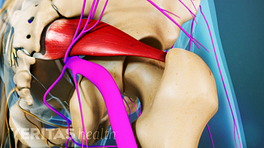Almost every treatment approach for piriformis syndrome will include a focus on carefully and progressively stretching the piriformis muscle.
Video: Sciatica Exercises for Piriformis Syndrome
These exercises can help to relieve sciatica pain from piriformis syndrome. Watch Now
Stretches for Piriformis Syndrome
A number of stretching exercises for the piriformis, hamstrings and hip extensors may help decrease the painful symptoms along the sciatic nerve and return the patient’s range of motion.
Piriformis stretches
There are a number of ways to stretch one's piriformis muscle. Two simple ways include:
- Lie on the back with both feet flat on the floor and both knees bent. Pull the right knee up to the chest, grasp the knee with the left hand and pull it towards the left shoulder and hold the stretch. Repeat for each side.
- Lie on the back with both feet flat on the floor and both knees bent. Rest the ankle of the right leg over the knee of the left leg. Pull the left thigh toward the chest and hold the stretch. Repeat for each side.
Each piriformis stretch should be held for 5 seconds to start, and gradually increased to hold for 30 seconds, and repeated three times each day.
Hamstring stretches
Stretching the hamstrings (the large muscle along the back of each thigh) is important to alleviate any type of sciatic pain. There are a number of ways to stretch the hamstrings:
- Place two chairs facing each other. Sit on one chair and place the heel of one leg on the other chair. Lean forward, bending at the hips until a gentle stretch along the back of the thigh is felt, and hold the stretch.
- Lie on the back with both legs straight. Pull one leg up and straighten by holding on to a towel that is wrapped behind the foot until a mild stretch along the back of the thigh is felt.
Again, try to work up to holding each stretch for 30 seconds and repeat three times each day.
Physical Therapy for Piriformis Syndrome
In addition to basic stretching, a comprehensive physical therapy and exercise program can be developed for each patient’s individual situation.
Range of motion exercises
A physical therapist, physiatrist, chiropractor or other qualified health practitioner can develop a customized program of stretching and range of motion exercises to help stretch the muscle and decrease spasm.
Deep Massage
Deep massage therapy (manual release) by a qualified specialist is thought to enhance healing by increasing blood flow to the area and decreasing muscle spasm.
In addition to stretching and physical therapy, most treatment approaches for piriformis syndrome will include additional therapies, discussed on the next page.







